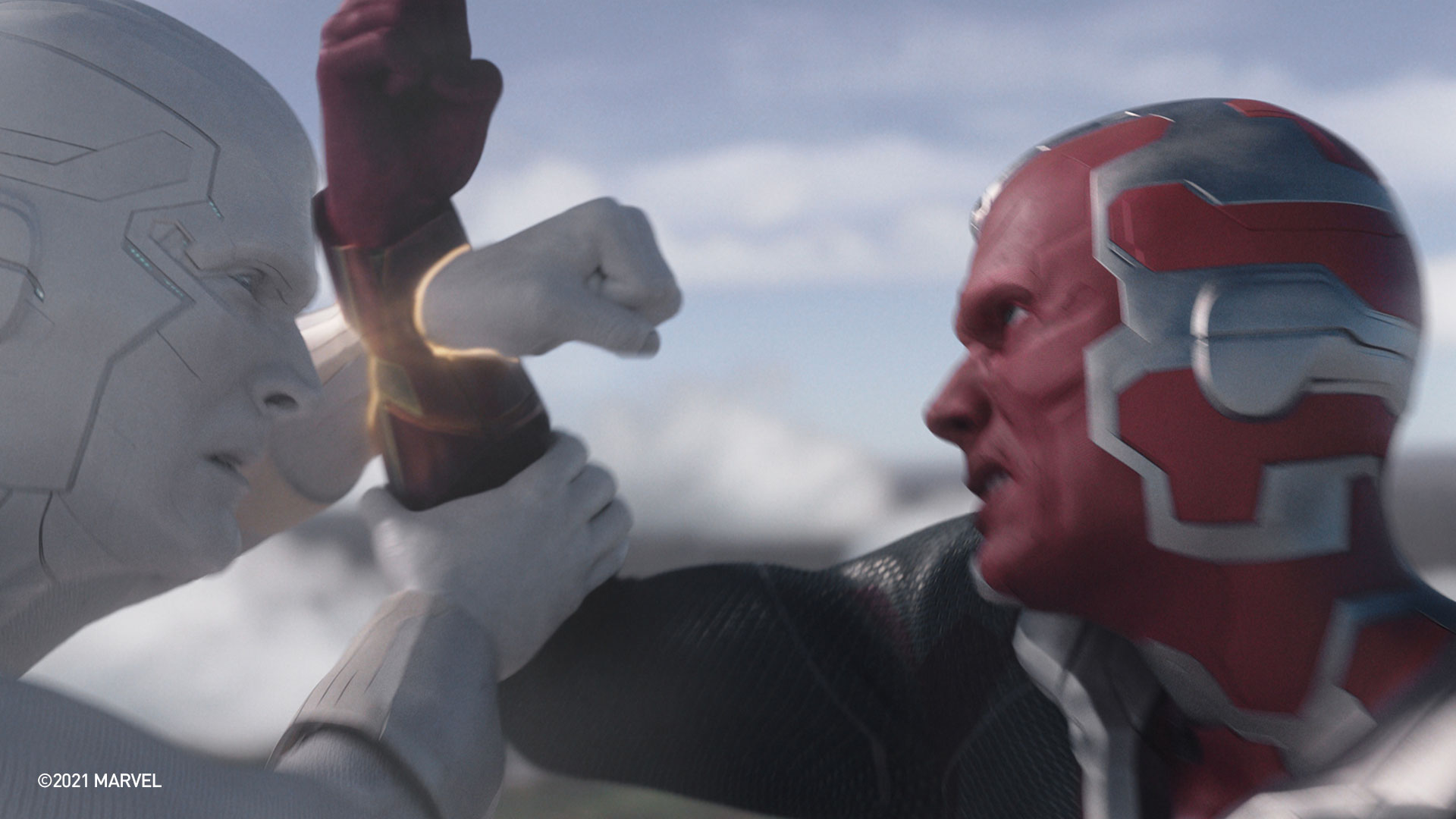Marion Spates started his career in visual effects almost 20 years ago. He has worked at many studios such as Digital Dimension, Method Studios and Uncharted Territory before joining Digital Domain in 2019. He has worked on various shows such as White House Down, Divergent, Independence Day: Resurgence and Lost in Space.
How did you and Digital Domain get involved on this series?
Digital Domain was involved with the show beginning January 2020, and we were asked to be on set in late Feb/early March, which turned out to be right before the pandemic hit the United States and we went into lockdown. Marvel was able to complete the remainder of the filming in September and October 2020.
How was the collaboration with Director Matt Shakman and VFX Supervisor Tara DeMarco?
Marvel was an excellent partner throughout the creative process at every level, and our work with Matt and Tara was very much a collaborative effort. They both knew what they wanted for every episode, but also encouraged collaboration and never turned down a good idea. Early on we got involved in previs and postvis, and during this stage we were able to offer our creative thoughts.
What was their approach and expectations about the visual effects?
Marvel approached this episodic show very much like one of their films: very ambitious with loads of MCU action packed story telling, but in this instance it was all viewed from the comfort of our homes. The show needed to exceed a certain level of quality, and I think we achieved this goal.
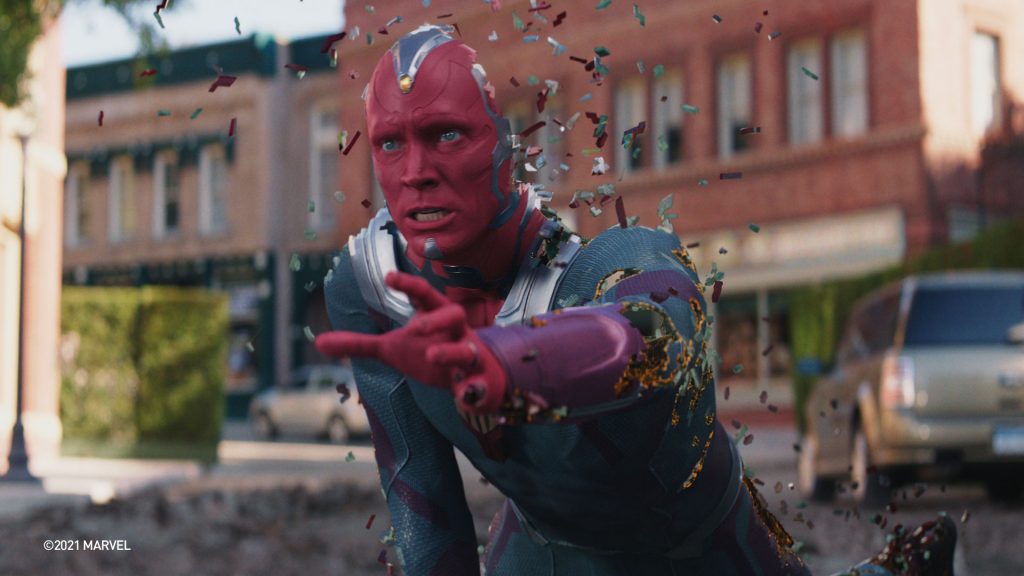
How was the work split amongst the Digital Domain offices?
Due to Digital Domain’s robust workflow, we worked on all sequences as a unit. We utilized artists of all disciplines across North America, splitting the work between our offices in Playa Vista, Vancouver and Montreal. All disciplines from asset creation to final shot work were touched by all three locations.
What are the sequences made by Digital Domain?
We were responsible for shots in episodes 4, 8 and 9, which included work on the House of M, the Hex wall opening, the glimpse of (dead) Vision, the reveal of (White) Vision, all of the Vision-on-Vision battle and the Agatha vs. Scarlet Witch battle that included the introduction of chaos magic.
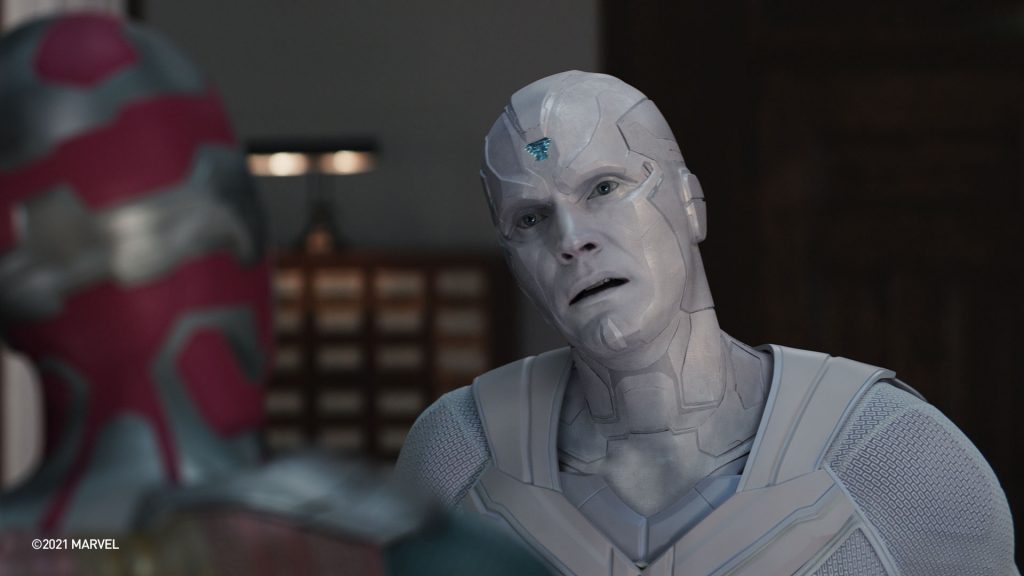
What kind of brief and influences did you receive to design the Hex?
The overall look of the hex wall came from WandaVision’s VFX Supervisor, Tara DeMarco, and it is actually an homage to old school tube-based television sets. The wall is meant to reflect the look of a cathode-ray tube television, complete with glitchy lines caused by interference, and a different color scheme used to reflect Wanda’s emotional state.
The creation of the hex wall was driven by the story, and there are several details in it that are a direct reflection of the show’s TV and sitcom-inspired nature. The wall is also influenced by Wanda’s emotional state, so in episode 104 when you first see the wall from the outside it is a calm blue, but in the final moments when Wanda is angry, it is a dark red.
This barrier is full of animations and little details. Can you elaborate about this aspect?
The hex wall is made up of three elements inspired by cathode-ray tube TVs, the type of set that would be at home in the older sitcoms referenced in the show.
The first was an effect called “phosphor pattern,” which is inspired by what you’d see if you placed a powerful magnet next to a CRT screen – the image would distort. The second effect was “cathodic lines,” which mimicked the lines you’d occasionally see across a CRT TV. The third was the “cathodic panels,” which are smaller cubes that add detail to the image. All three made up the hex wall.
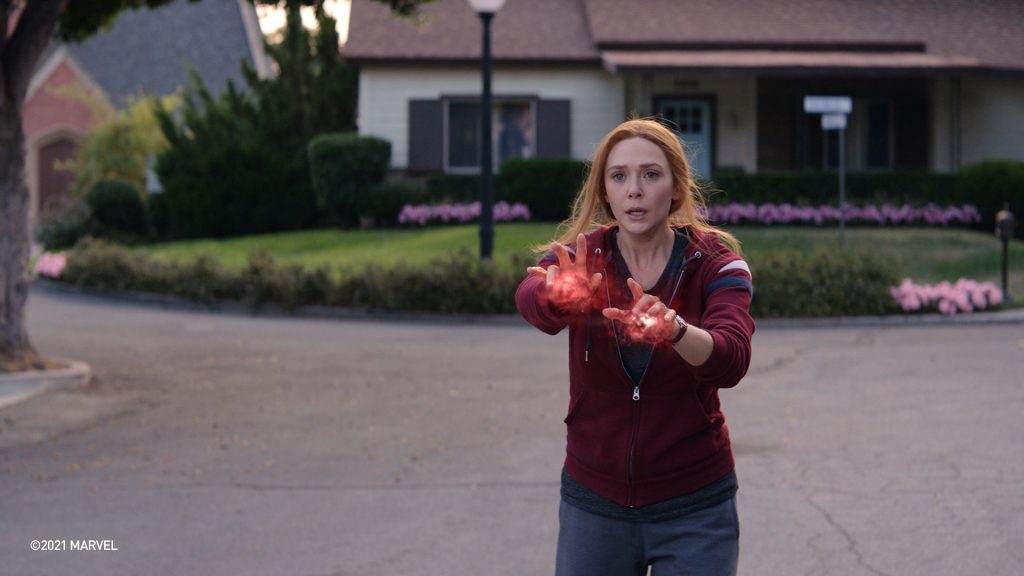
Can you tell us more about the Hex opening?
Our effects team built the hex wall by layering in the moving TV-inspired effects, generating animated passes that erratically tear, and represented these elements within the hex. It was then passed off to comp, who created the final look of the hex.
During the opening of the hex wall, Wanda is forced to rip open the wall to let the citizens of Westview out. The studio was adamant that the tearing of the wall feature the glitch effect, and the wall itself was heavily influenced by the look of old CRT televisions that frequently have scan lines. The effect was meant to be reminiscent of a TV under stress, which played into the story.
How did you work with the art department for White Vision?
Marvel created their own concept art for White Vision, and on set we scanned and photographed it with high resolution cameras, creating a three-dimensional representation of the suit. We then sculpted it from top to bottom. The head was a special case, as there was no head on set for Paul. We took Red Vision’s head, and Chris Nichols, one of the great concept artists at DD, used ZBrush to sculpt what the White Vision’s head could look like, including details on the front and back. There are a few key differences between the two Visions, starting with the panels. White Vision’s panels are more angular and rigid to match the character’s stoic and aggressive nature. Red Vision is more personable and expressive, and the panels are more free flowing to match. Once we had the buy-off from Marvel on the 3D concept, it went to modelling, who built the final model.
It’s difficult to create an all-white character in a low or strongly lit environment, so one of the things we did to try to help complement the white was to introduce a thin film interference layer to his face that offered a slight variation of colors, seen at glancing angles that help break up the overall white color. The effect was modeled on the iridescent rainbow effect you see on a bubble when it catches the light in just the right way. That’s something the art department painted into the concept. We also created a really cool circuitry pattern in place of the Mind Stone, which was very much connected to the story and the origin of White Vision. When Paul was on set and dressed as the White Vision, he was a different person. It was amazing what he did.
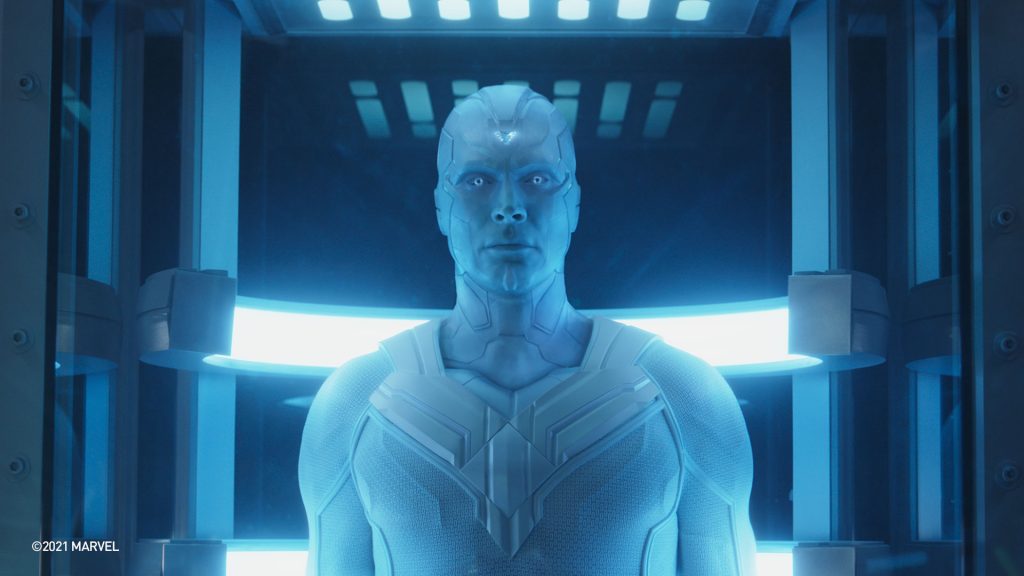
Can you explain in detail about the creation of the two Vision?
Just as we did with the White Vision, we took the Red Vision’s suit and scanned it, then photographed it with high detail cameras. The look of the Red Vision was already well established, but the models we had were from 2015, so we created a new set that we could use, which allowed us to get extremely close to both Red and White Visions.
In the scenes where Red Vision is fighting White, Paul recorded both sides of the encounter opposite a stuntman. We then replaced the stuntman’s head and body with Paul’s. In addition, we added capes, phasing and Mind Stone beam effects to finish off the shots.
How did you manage the challenges of the capes?
We started our development work on the cape simulations early. We received animation tests from our animation team led by Frankie Stellato, after which our CFX team, led by Eric Ojong and Sunil Rawat, began looking at all the possibilities for creating the Vision capes.
Character Effects lead Eric Ojong added:
“Paul Bettany and the stunt doubles never wore capes on set, so each time you see one it’s simmed. We had to employ tight matchmove to the shoulder plates, and after matchmove and animation were approved, our CFX team would run the sim cape using the body as a collider. In specific cases where the cape had to look a specific way (usually when Vision was on the ground), we would have to adjust the direction of gravity, or Vision’s starting pose before the shot even began. For the flying shots, the cloth attributes were adjusted depending on the shot requirements, with a focus on the timing, direction and speed of the wind on the cape.”
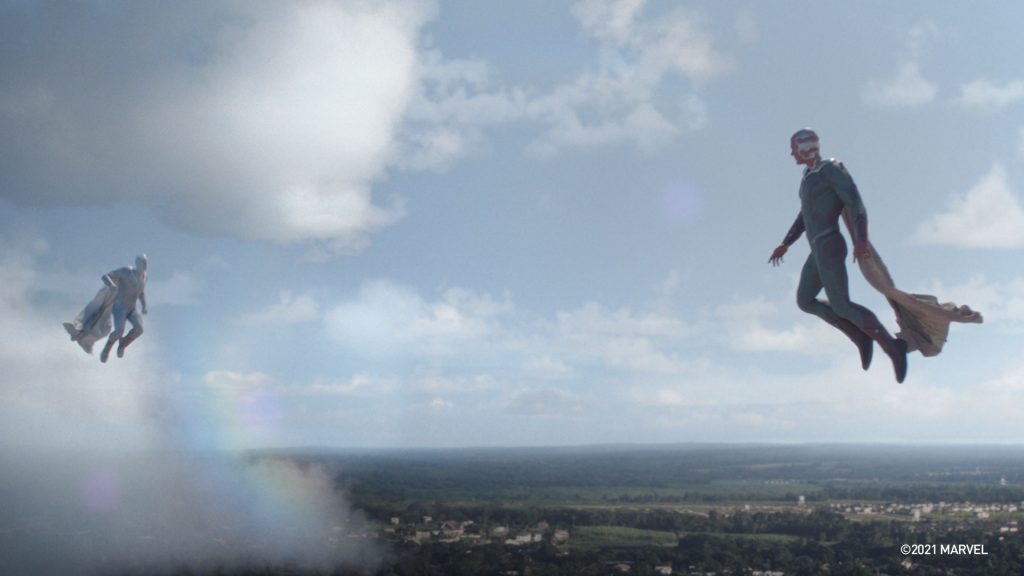
Both Visions are really powerful, how does that affect your work?
It was really cool having two characters with nearly identical powers battle one another. (Red) Vision would throw a punch and try to impale (White) Vision, and (White) Vision would increase density to try and trap the other. For the look of the innards, our Character Effects Dept Supervisor Jimmy Gordon and team came up with a way to use a component of our proprietary skin/fat/fascia/muscle solving tool, SMEAT, which is called the “muscle transfer tool.”
Can you explain in detail about the creation of the flying shots?
The flying shots for Agatha and Scarlet Witch involved a mixture of wire work and digi-doubles. The challenge with Agatha is that her dress was light and airy, so parts of it would get caught on the wires as it was blowing in the wind. To remedy this, we had to matchmove and apply cloth sims to match the action. After the sim was approved and rendered, our comp team decided which area was best for blending.
Can you elaborate about the creation of Scarlet Witch in all her glory?
To help introduce Wanda as the Scarlet Witch, it began with nailing the look of her new chaos magic powers. Wanda’s previous powers were known (informally) as “wiggly-woo” magic, and were made up of a bright red swirling energy. We worked closely with Marvel to determine the look of the new chaos magic, and went through well over 100 iterations before selecting the final version that audiences saw.
Her new chaos magic is much darker and more menacing, and has more dimension and depth to it. To create that look, one of our DFX Supervisors, Matt Smith, had the idea to create a planet element within the chaos ball. Using that geometric element, we were able to add depth and a lot of the detail to Wanda’s chaos ball.
We also worked on the first look at Wanda as Scarlet Witch after she embraces the chaos magic. Marvel had the concept art for her new costume, which honors the comic origins, including her iconic crown.
The battle is full of FX. How did you create and animate them?
The bulk of our work on WandaVision was in the final episode. We worked with Marvel to develop the fight between Agatha and Wanda, as well as the confrontation between the two Visions. In many ways it was similar to one of the climactic battles you’d see in any of the MCU films.
The fight between Red and White Vision was especially interesting as both Visions have the ability to shift their densities. As they fly over Westview, each Vision tries to use that ability against the other. One Vision tries to lighten their density to impale the other, while the recipient tries to increase their density to trap the attacker in place. To make that look as real as possible, our new “muscle transfer tool” allowed our artists to automatically move muscle models between characters. We then matched the augmented shape of the outer skin, and added a layer of high-tech synthetic-looking skin to reference Vision’s vibranium shell.
For the fight between Agatha and Wanda that saw the pair flighting in the skies over Westview, we used the same workflow we use in the Marvel feature films.
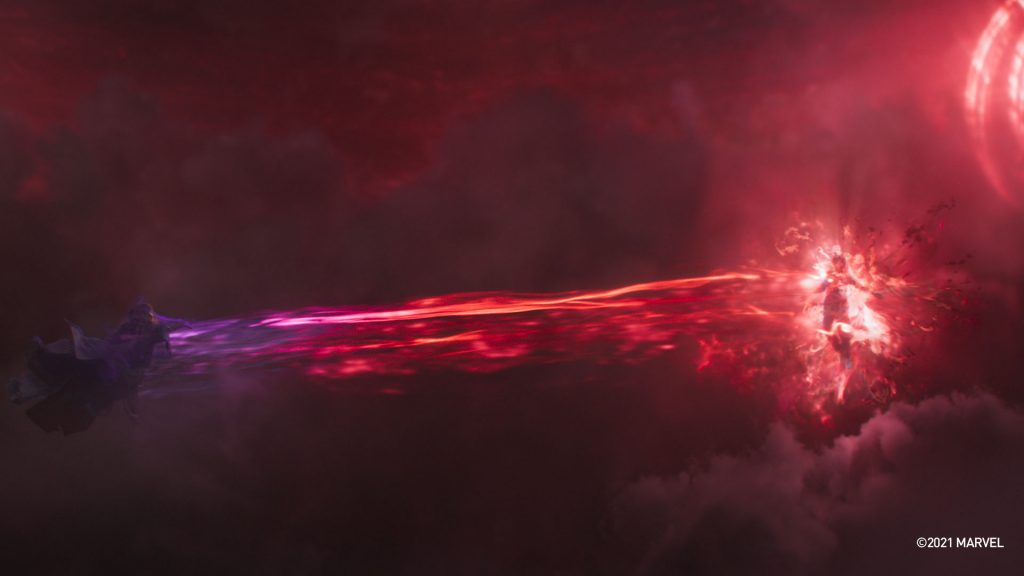
Can you explain in detail about the creation of Westview and its environments?
We did quite a bit on Westview, starting with the cul de sac where Agatha has Wanda and Vision’s children hostage. One end of that street was entirely bluescreen – everything including the Winnebago and the house was 2.5D matte paintings. We also did all of the sky battle shots between Wanda and Agatha and the two Visions, and added the environments to match. A lot of that was shot in Georgia during the winter, so we had to go through each scene and augment it to match the setting and on-screen climate. We also extended homes, put trees in and included additional details. For these environments we used plates that we shot at the Disney Ranch and Blondie Street at Universal, but primarily it was digital recreations of environments. Some of it was also based on photogrammetry passes of a town outside of Atlanta called Eatonton, Georgia, which provided a lot of the small town feel of Westview.
During production, the showrunners decided to change the scope of the fight between Wanda and Agatha. Initially, it was all going to be in the clouds, but the director understandably wanted to connect the witch battle with what was happening in the town, with Monica and the rest of Wanda’s family. We had limited plates of the town square from the Disney Ranch, so our environment team extended it to create a digital world the witches could fly around. Our team did an incredible job of building the town square and some of the surrounding areas in less than six weeks.
What were the main challenges with these two epic fights?
The fight between the two Visions included an aerial duel that required a combination of practical wire effects and CG digi-doubles. For the close-ups, Paul Bettany performed as each Vision (Red and White). They were similar, but drastically different performances. Digital Domain replaced the stunt person’s head and body with Bettany’s, and integrated its CG models into each of Bettany’s plates, which were altered to make the transition seamless. The result gave Bettany a fully nuanced performance for each side of the fight.
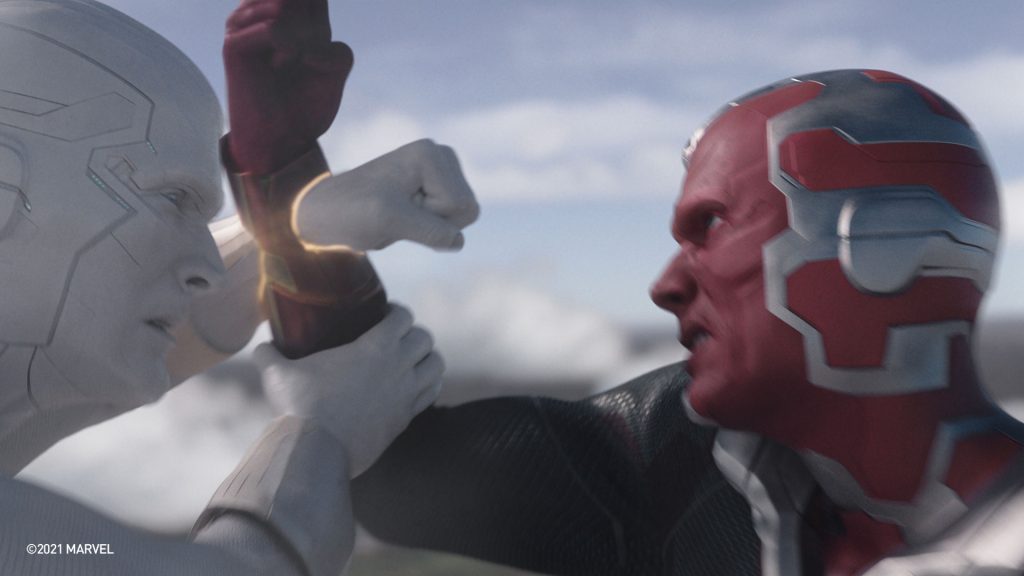
Which sequence or shot was the most challenging?
The sky battles for both the Visions and the witches would have to be the hardest, in my opinion. There’s multiple challenges when making actors feel like they are flying, both onset and during post production.
Is there something specific that gives you some really short nights?
To be honest, there’s nothing specific that stands out, however the schedule was very ambitious so our team had several short nights. The team was incredible, I could not be more proud of all the hard working individuals on the show.
What is your favorite shot or sequence?
My favorite sequence would be the Library sequence. Bringing Vision and White Vision to life was a great experience, and something I will remember for a long time. Paul’s performance was inspirational to the team. He did an amazing job!
What is your best memory on this show?
Completing principle photography would have to be my favorite. It was great knowing we were able to move forward and work on the show after waiting months due to the pandemic.
How long have you worked on this show?
14 months.
What’s the VFX shots count?
350.
What is your next project?
Unfortunately, we can’t talk about upcoming projects, but we have a lot of big things in the works.
A big thanks for your time.
WANT TO KNOW MORE?
Tara DeMarco: My interview of Overall VFX Supervisor Tara DeMaco about WandaVision.
Digital Domain: Dedicated page about WandaVision on Digital Domain website.
Disney+: You can watch WandaVision now on Disney+.
© Vincent Frei – The Art of VFX – 2021


